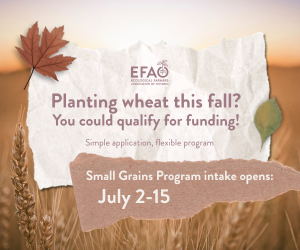Public and private corn breeding – a behind the scenes tour
HOW PUBLIC PROGRAMS AND PRIVATE INDUSTRY IN CANADA COMPLIMENT EACH OTHER
the improved yield and disease resistance Canadian-adapted corn hybrids have demonstrated during the last few decades has been truly impressive. Growers know a lot of time and effort goes into the development of new corn hybrids, but may not be aware of how the efforts of both private companies and publically-funded scientists intersect.
Dr. Lana Reid is Agriculture and Agri-Food Canada’s (AAFC) only dedicated corn breeder. Based in Ottawa, she leads the national public corn breeding program, which includes trials from Alberta to PEI, as well as collaborative yield trial exchanges with companies at sites across Canada. “Our focus is to import new corn germplasm and adapt it for Canadian growing conditions,” she explains. “We work with a broad diversity of germplasm, and many seed corn companies do not have the resources for this, so demand for AAFC inbreds increases every year – especially those that perform in more marginal areas where private firms have no breeding program.” Since AAFC corn breeding began 83 years ago, dozens of new genotypes have been produced that have helped expand corn production in areas such as eastern Ontario and Quebec, and Reid and her colleagues maintain all these previously-released inbreds.
modern pressures
Today’s corn crop faces many other pressures besides the need for early maturity and cold tolerance at the seedling stage. “While yields have increased substantially, they did so during a time when energy inputs like fertilizer, pesticides and drying costs were relatively inexpensive,” Reid says. “Costs have gone up substantially and AAFC is therefore developing hybrids with faster dry-down rates that will cut drying costs for growers, as well as longer-season hybrids which may produce greater yields.”
At the same time, the number and severity of diseases has increased, so pressure to produce resistant hybrids is stronger than ever. “The seed corn industry in Canada does not do breeding for resistance to all major Canadian corn diseases, but a strong part of our research is to collect, adapt and develop new sources of resistance to all of them,” says Reid. These include common rust, northern leaf blight, eyespot, Fusarium ear rot, Fusarium stalk rot, anthracnose stalk rot, common smut and grey leaf spot, with AAFC putting a major emphasis on gibberella ear rot, a common type of Fusarium. “We are the only public program to have released gibb [Fusarium] resistant inbreds in North America and some of these are proving to be the most resistant public inbreds available internationally,” Reid says with pride.
Breeding to combat this type of Fusarium is very difficult to do as sources of resistance are few and the disease is highly influenced by environmental conditions and other species of Fusarium that are present. “Only one company in Canada has consistently done gibb [Fusarium] resistance breeding on Canadian soil,” observes Reid. “AAFC provides this one and others with the technology and fungal inoculum to do breeding on their own research farms.” In addition to Fusarium in corn, Reid says AAFC-Ottawa has a large team of scientists working on Fusarium head blight in wheat (which is caused by the same fungal pathogen as gibb). “Dr. Linda Harris and Dr. Jas Singh are working to find the genes associated with resistance and developing new sources of gibb resistance,” says Reid. “We also have local and international grad students working on various aspects associated with resistance.”
projects at the university of guelph
Dr. Laima Kott, a research scientist in the department of Plant Agriculture at University of Guelph, is developing Fusarium-resistant corn for livestock feed. “We’re developing a novel method that entails inducing immature corn pollen grains to develop into embryos that germinate into inbred corn plants,” she says. “We’re also adding specific chemicals to the growth media of embryos and using UV light to create mutants, some of which may carry Fusarium resistance.” Kott notes that conventional breeding done by private companies has revealed how physical factors such as pericarp thickness and husk confer Fusarium resistance. “Several private research groups are also attempting DNA marker assisted selection,” she adds.
Other public breeding focuses, as in private industry, are the development of new traits for the biofuel industry, drought resistance and reduced plant height/high harvest index. Dr. Liz Lee, Professor and corn breeder in the Department of Plant Agriculture at the University of Guelph is studying the traits that allow individual plant yield increases at high plant population densities.
These three publically-funded corn breeding programs are funded through several sources including the Developing Innovative Agri-Products Program, Natural Science and Engineering Research Council and farm organizations like Grain Farmers of Ontario and the Manitoba Corn Growers’ Association.
continued improvements
Canadian corn production has made remarkable progress by pushing production into areas of shorter growing seasons and hybrids that are higher yielding and less prone to insect and disease damage, says Dr. William Leask, Canadian Seed Trade Association Executive Vice-President. “There will continue to be improvements that will meet the environmental challenges of reducing pesticide use and better drought tolerance due to climate change,” he notes. “The public sector breeders play a key role in providing basic research and improved germplasm that can be added to private sector breeding programs for further improvement and commercialization.” •

















